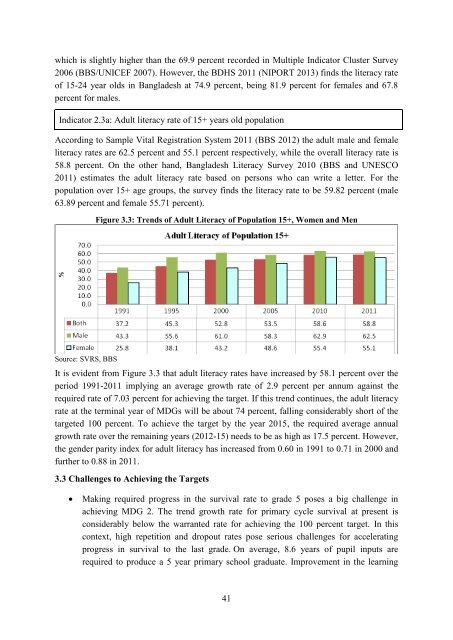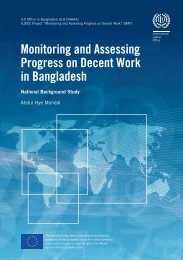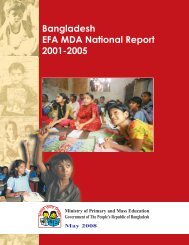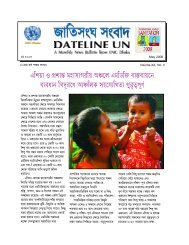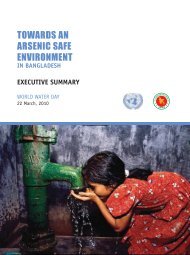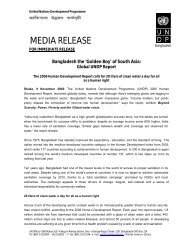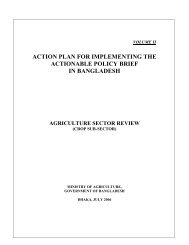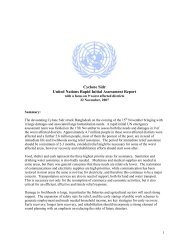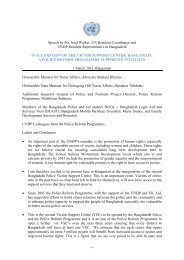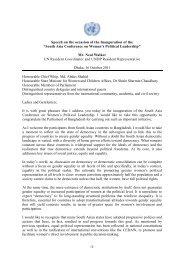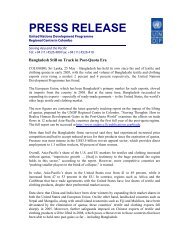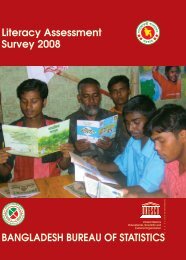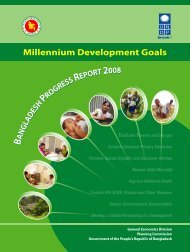MDG Report 2012 - United Nations in Bangladesh
MDG Report 2012 - United Nations in Bangladesh
MDG Report 2012 - United Nations in Bangladesh
- No tags were found...
Create successful ePaper yourself
Turn your PDF publications into a flip-book with our unique Google optimized e-Paper software.
which is slightly higher than the 69.9 percent recorded <strong>in</strong> Multiple Indicator Cluster Survey2006 (BBS/UNICEF 2007). However, the BDHS 2011 (NIPORT 2013) f<strong>in</strong>ds the literacy rateof 15-24 year olds <strong>in</strong> <strong>Bangladesh</strong> at 74.9 percent, be<strong>in</strong>g 81.9 percent for females and 67.8percent for males.Indicator 2.3a: Adult literacy rate of 15+ years old populationAccord<strong>in</strong>g to Sample Vital Registration System 2011 (BBS <strong>2012</strong>) the adult male and femaleliteracy rates are 62.5 percent and 55.1 percent respectively, while the overall literacy rate is58.8 percent. On the other hand, <strong>Bangladesh</strong> Literacy Survey 2010 (BBS and UNESCO2011) estimates the adult literacy rate based on persons who can write a letter. For thepopulation over 15+ age groups, the survey f<strong>in</strong>ds the literacy rate to be 59.82 percent (male63.89 percent and female 55.71 percent).Figure 3.3: Trends of Adult Literacy of Population 15+, Women and MenSource: SVRS, BBSIt is evident from Figure 3.3 that adult literacy rates have <strong>in</strong>creased by 58.1 percent over theperiod 1991-2011 imply<strong>in</strong>g an average growth rate of 2.9 percent per annum aga<strong>in</strong>st therequired rate of 7.03 percent for achiev<strong>in</strong>g the target. If this trend cont<strong>in</strong>ues, the adult literacyrate at the term<strong>in</strong>al year of <strong>MDG</strong>s will be about 74 percent, fall<strong>in</strong>g considerably short of thetargeted 100 percent. To achieve the target by the year 2015, the required average annualgrowth rate over the rema<strong>in</strong><strong>in</strong>g years (<strong>2012</strong>-15) needs to be as high as 17.5 percent. However,the gender parity <strong>in</strong>dex for adult literacy has <strong>in</strong>creased from 0.60 <strong>in</strong> 1991 to 0.71 <strong>in</strong> 2000 andfurther to 0.88 <strong>in</strong> 2011.3.3 Challenges to Achiev<strong>in</strong>g the TargetsMak<strong>in</strong>g required progress <strong>in</strong> the survival rate to grade 5 poses a big challenge <strong>in</strong>achiev<strong>in</strong>g <strong>MDG</strong> 2. The trend growth rate for primary cycle survival at present isconsiderably below the warranted rate for achiev<strong>in</strong>g the 100 percent target. In thiscontext, high repetition and dropout rates pose serious challenges for accelerat<strong>in</strong>gprogress <strong>in</strong> survival to the last grade. On average, 8.6 years of pupil <strong>in</strong>puts arerequired to produce a 5 year primary school graduate. Improvement <strong>in</strong> the learn<strong>in</strong>g41


